112 Walls


Echo
Name/Title
Echo
Lexicon
Description
Carved marble statue of Echo by Larkin Mead. Echo stands in a slightly contrapposto pose, weight off her right foot, and holds a horn just above her shoulder in her left hand. Her face is turned to the right, seemingly looking into the distance. Her right hand rests by her hip, stretched out for balance away from her side. The nymph is barefoot and is supported by a decorative floral carved marble post at her back.
Acquisition
Accession
2024.6
Relationships
Related Person or Organization
Mead, Larkin Goldsmith (1835-1910)
Person or Organization
Related Places
Place
Brattleboro
Town
Windham County
County
Vermont
State/Province
United States of America
Country
North America
Artwork Details
Medium
Marble
Subject
Echo (nymph)
Made/Created
Artist Information
Mead, Larkin Goldsmith (1835-1910)
Artist
Sculptor
Role
Dimensions
Dimension Description
overall; diameter measured at base
Entry/Object ID
2024.6.1
Context
Vermont sculptor Larkin Mead is most famous for designing the original statue atop the Vermont Statehouse. He spent much of his later career in Italy - this statue was probably produced there and was part of his personal collection.
Web Links and URLs
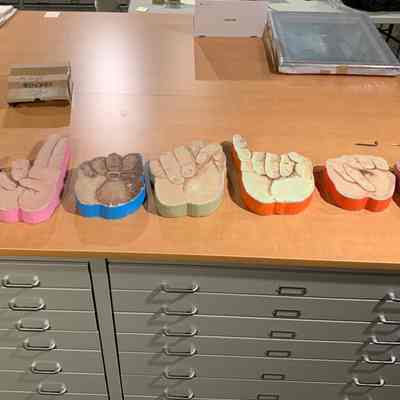
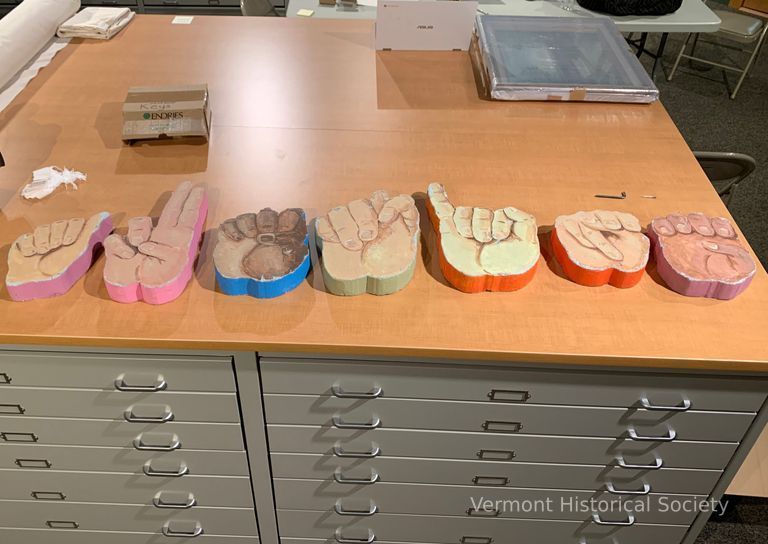
Hand Gestures Sign
Name/Title
Hand Gestures Sign
Description
Large sign spelling in seven separate hands each in the position of a sign language letter. It spells 'AUSTINE" all together. Each hand (a-g) is of paper mâché with the hand painted and outlined in realistic detail. Delineating sides with a solid color (pink a-b) (blue, c) (green, d) (orange e-f) and (purple, g) Painting on back of letters is black with each represented letter painted in multi-color and capitalized.
The sign was sculpted by artist Chuck Baird alongside Austine students during a visit in 2001.
The sign was sculpted by artist Chuck Baird alongside Austine students during a visit in 2001.
Acquisition
Accession
2024.16
Made/Created
Artist Information
Chuck Baird
Artist
Media Artist
Role
Dimensions
Materials
Material Notes
Paper mâché hands that have been painted for wall secure they include small metal loops with either clear plastic or rope loops for wall attachment
Material
Papier-mâché, Paint, Metal, Plastic, Rope
Entry/Object ID
2024.16.6a-g
Context
Austine School for the Deaf Brattleboro, VT
Chuck Baird (Feb. 22, 1947-Feb 10, 2012) was one of the founding members who in 1989 defined through its manifesto, and actively practiced the art movement of De'VIA (Deaf Visual Image Art). As a result he is considered one of the "fathers" of the movement, and one of the practitioners of its "first wave" (1989-2009). De'VIA is defined as art created expressing the experience of deaf culture in any media format (including depictions of American Sign Language).
Chuck Baird (Feb. 22, 1947-Feb 10, 2012) was one of the founding members who in 1989 defined through its manifesto, and actively practiced the art movement of De'VIA (Deaf Visual Image Art). As a result he is considered one of the "fathers" of the movement, and one of the practitioners of its "first wave" (1989-2009). De'VIA is defined as art created expressing the experience of deaf culture in any media format (including depictions of American Sign Language).
Web Links and URLs
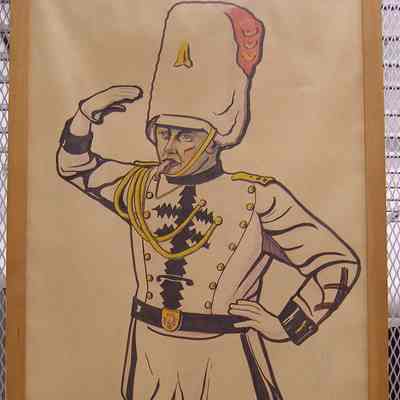
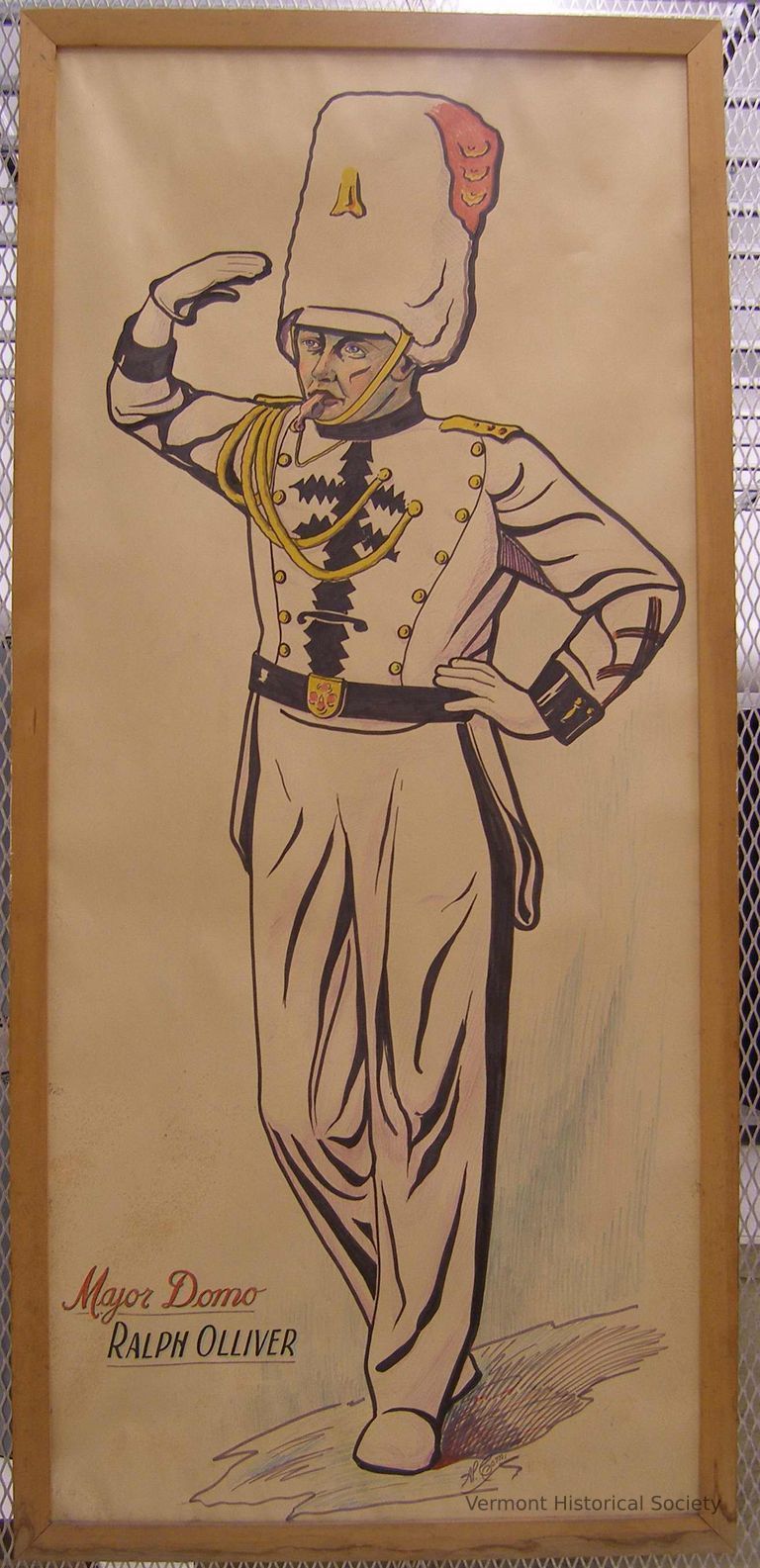
Major Domo
Name/Title
Major Domo
Lexicon
Description
Large-format drawing depicting a man in a white drum major's uniform. The figure is depicted with a whistle in his mouth, his left hand resting on his left hip, and his right hand positioned in a semi-saluting gesture. He is wearing a tall fur hat with a red plume, and has several yellow ropes attached to his right shoulder. The bottom right of the composition has the decoratively written title, "Major Domo/Ralph Olliver." The work is signed in the lower right, "Al Comi."
Acquisition
Accession
2006.40
Relationships
Related Places
Place
Barre City
City
Washington County
County
Vermont
State/Province
United States of America
Country
North America
Artwork Details
Medium
Ink, Gouache
Subject Person
Olliver, C. Ralph (1899-1979)
Made/Created
Artist Information
Comi, Alfred Joseph Peter (1900-1986)
Artist
Date made
circa 1965
Dimensions
Dimension Description
Overall (framed)
Entry/Object ID
2006.40.1
Type of Drawing
Context
Ralph Olliver was as outsized in his local fame as this large image by noted Barre artist Al Comi. Olliver, born in 1899 and a WWI veteran, served as Barre City Clerk for 50 years (1926 to 1976). At about the same time he started his first Clerk term, he joined the American Legion Post 10 Drum and Bugle Corps. He initially tried his hand at bass drum, but in his words, "That's when they decided I was making too much noise. I was a big fellow, and they figured I'd stand out any way, so they gave me the baton, told me to go up front and be the frum major and keep quiet."
Olliver became a fixture at Barre and other local parades through the 1930s. The Legion band folded in 1936 due to lack of members, but came roaring back in the years following WWII with a fresh infusion of veterans. Olliver continued to serve as the Legion drum major and soon became the leader of the Shriners band. As the drum major for the Shriners he travelled all over the U.S. and Canada and became well known for his parade-leading abilities. He retired from the drum major position in 1965 as his knees started to give him trouble. This drawing probably dates from about this time.
At the time of his retirement from the Barre City Clerk's office in 1976, Olliver was the longest serving city clerk in Vermont, a record that still stands today. Through his time in office he saw the 1927 flood, the great depression, the large CCC works in and around Barre, the construction of the Barre City Auditorium, and the development of the new Spaulding High School and Technical Center. He named the funding and construction of the Barre City Auditorium in 1939 as one of his greatest achievements.
Olliver became a fixture at Barre and other local parades through the 1930s. The Legion band folded in 1936 due to lack of members, but came roaring back in the years following WWII with a fresh infusion of veterans. Olliver continued to serve as the Legion drum major and soon became the leader of the Shriners band. As the drum major for the Shriners he travelled all over the U.S. and Canada and became well known for his parade-leading abilities. He retired from the drum major position in 1965 as his knees started to give him trouble. This drawing probably dates from about this time.
At the time of his retirement from the Barre City Clerk's office in 1976, Olliver was the longest serving city clerk in Vermont, a record that still stands today. Through his time in office he saw the 1927 flood, the great depression, the large CCC works in and around Barre, the construction of the Barre City Auditorium, and the development of the new Spaulding High School and Technical Center. He named the funding and construction of the Barre City Auditorium in 1939 as one of his greatest achievements.
Web Links and URLs
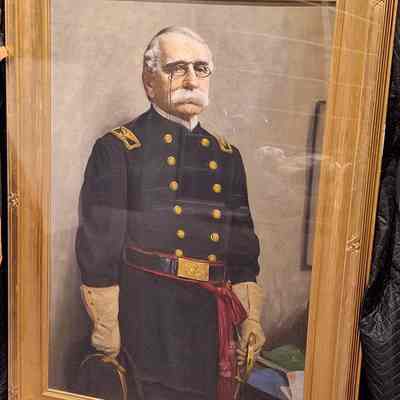
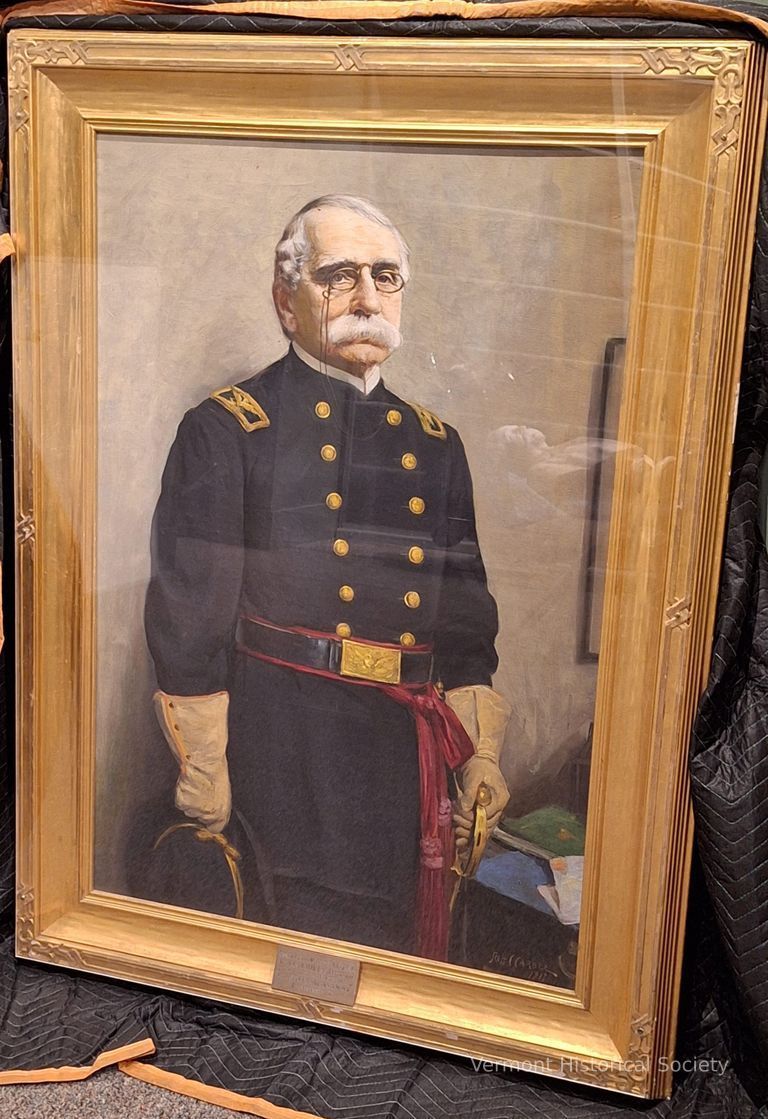
Portrait
Name/Title
Portrait
Type of Painting
Description
Oil on canvas portrait of Colonel William Austine. The Colonel stands in a simple interior space with a pale gray/green wall behind him. He is wearing glasses and his dress uniform with simple rectangular epaulettes, tan gloves, crimson sword belt and black belt over top with gold buckle. He holds his sword in his left hand and black hat with gold band in his right. There is a painting on the wall just behind his left shoulder, and a stack of books and papers on a desk by his left hand. The painting is signed "Scott C CARBEE 1917" in the lower right corner and rests in a simple geometric-carved gilt frame. There is a name plate attached to the bottom center of the frame that reads, "COL. WILLIAM AUSTINE, U.S.A. / BORN JAN. 8, 1815, DIED, SEPT. 4, 1904 / PORTRAIT PRESENTED BY / HON. HENRY D. HOLTON A.M., M.D. / BRATTLEBORO, VT."
Acquisition
Accession
2024.16
Artwork Details
Medium
Oil on Canvas
Subject
Colonel William Austine
Made/Created
Artist Information
Scott Clifton Carbee
Artist
Painter
Role
Date made
1917
Dimensions
Dimension Description
Overall
Entry/Object ID
2024.16.14
Context
Colonel William Austine graduated the University of Chicago in 1838 and joined the 2nd Dragoons as Second Lieutenant, shortly after this he joined the 3rd Artillery also as Second Lieutenant a rank he held for much of his military career. He served in the Florida War (1838-1842), in the Mexican-American War in the Siege of Vera Cruz (1847), Battle of Cero Gordo (1847), Skirmish of Amazoque (1847), Capture of San Antonio (1847), and the Battle of Churubusco (1847) during which time he was promoted to Captain. He then served in Ft Adams R.I (1848-1849), in the Florida hostilities against the Seminole Tribe (1849-1850), back in Ft. Adams until 1852, Ft. Constitution N.H. (1852-1853), Ft. Wood N.Y. until 1854, 1854-1861 on sick leave. 1861 he served in San Francisco during the Rebellion of the Seceding States as Superintendent for Mustering and Recruiting for the State of Vermont until 1866. In 1865 he was promoted to Lieutenant-Colonel and then Colonel. He retired from active duty after this.
According to the Austine School for the Deaf, in his will, the Colonel specified a sum of $50,000 to create a hospital for "the treatment of strangers or local residents with extraordinary circumstances." According to school history, "five prominent local citizens incorporated the Austine Insititute in 1904." In the end it was the decision of the Vermont Attorney General to open a school for deaf and blind students in 1912.
According to the Austine School for the Deaf, in his will, the Colonel specified a sum of $50,000 to create a hospital for "the treatment of strangers or local residents with extraordinary circumstances." According to school history, "five prominent local citizens incorporated the Austine Insititute in 1904." In the end it was the decision of the Vermont Attorney General to open a school for deaf and blind students in 1912.
Web Links and URLs
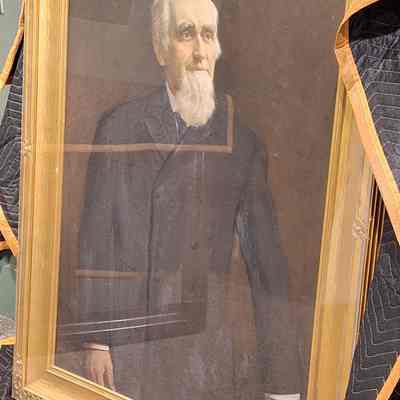
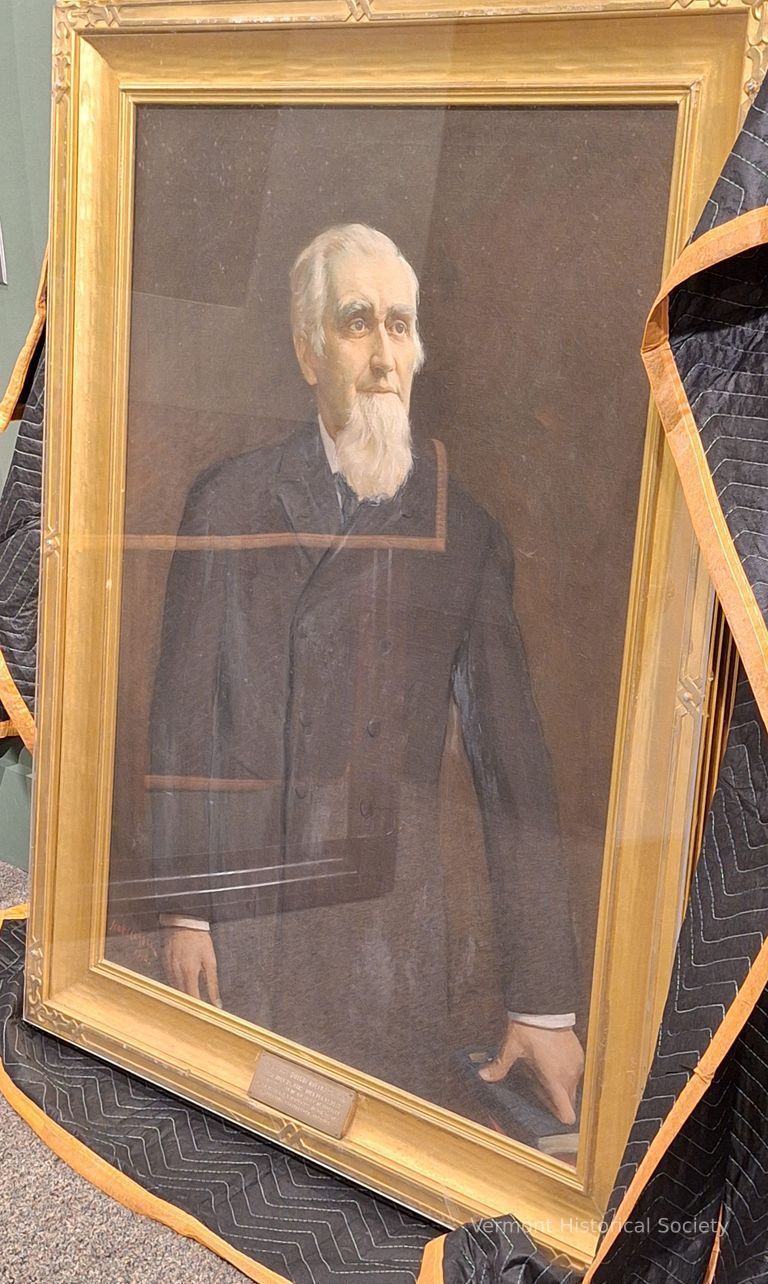
Portrait
Name/Title
Portrait
Type of Painting
Description
Oil on canvas portrait of Henry Holton by Scott C. Carbee. Dr. Holton stands tall against a dark background, looking just over the viewer's right shoulder and has short white hair and a medium-length white beard. He is dressed in a dark black coat and the white sleeves of his shirt are just visible at the wrists. His left hand rests on a stack of books. The painting is signed "Scott C CARBEE 1918" in red in the lower left corner and resides within a simple geometric-carved gilt frame. There is a name plate at the lower center of the frame that reads, "HON. HENRY DWIGHT HOLTON A.M, M.D. / BORN JULY 24, 1838, DIED FEB. 12, 1917. / FIRST PRESIDENT OF THE BOARD OF TRUSTEES AND A MUNIFICENT BENEFACTOR OF THE AUSTINE INSTITUTION, BRATTLEBORO, VERMONT."
Acquisition
Accession
2024.16
Artwork Details
Medium
Oil on Canvas
Subject
Dr. Henry Holton
Made/Created
Artist Information
Scott Clifton Carbee
Artist
Painter
Role
Date made
1918
Dimensions
Dimension Description
Overall
Entry/Object ID
2024.16.13
Context
Austine School for the Deaf Brattleboro, VT
Dr. Henry Dwight Holton (July 24, 1838-Feb. 12, 1917) was a general physician who moved to Brattleboro in his later life. He was involved in or established almost every medically-related institution of Brattleboro including the Holton Home for the Elderly and was one of the very first board members of the Austine School for the Deaf. His main concerns during his lifetime were for the betterment of medicine and education within the State of Vermont, and eventually rose to secretary of the Vermont State Board of Health, raising the health standards of the State of Vermont from 18th to 3rd in the United States. In his life he was president, or board member in many different organizations from international business to politics and taught surgery and medicine at multiple universities.
Dr. Henry Dwight Holton (July 24, 1838-Feb. 12, 1917) was a general physician who moved to Brattleboro in his later life. He was involved in or established almost every medically-related institution of Brattleboro including the Holton Home for the Elderly and was one of the very first board members of the Austine School for the Deaf. His main concerns during his lifetime were for the betterment of medicine and education within the State of Vermont, and eventually rose to secretary of the Vermont State Board of Health, raising the health standards of the State of Vermont from 18th to 3rd in the United States. In his life he was president, or board member in many different organizations from international business to politics and taught surgery and medicine at multiple universities.
Web Links and URLs